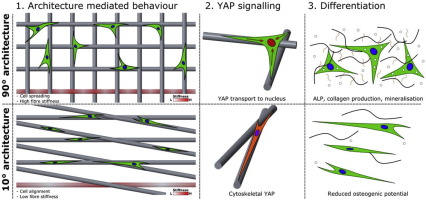Acta Biomaterialia ( IF 9.4 ) Pub Date : 2018-05-30 , DOI: 10.1016/j.actbio.2018.05.048 Kian F Eichholz 1 , David A Hoey 2

|
The architecture within which cells reside is key to mediating their specific functions within the body. In this study, we use melt electrospinning writing (MEW) to fabricate cell micro-environments with various fibrous architectures to study their effect on human stem cell behaviour. We designed, built and optimised a MEW apparatus and used it to fabricate four different platform designs of 10.4±2μm fibre diameter, with angles between fibres on adjacent layers of 90°, 45°, 10° and R (random). Mechanical characterisation was conducted via tensile testing, and human skeletal stem cells (hSSCs) were seeded to scaffolds to study the effect of architecture on cell morphology and mechanosensing (nuclear YAP). Cell morphology was significantly altered between groups, with cells on 90° scaffolds having a lower aspect ratio, greater spreading, greater cytoskeletal tension and nuclear YAP expression. Long term cell culture studies were then conducted to determine the differentiation potential of scaffolds in terms of alkaline phosphatase activity, collagen and mineral production. Across these studies, an increased cell spreading in 3-dimensions is seen with decreasing alignment of architecture correlated with enhanced osteogenesis. This study therefore highlights the critical role of fibrous architecture in regulating stem cell behaviour with implications for tissue engineering and disease progression.
Statement of significance
This is the first study which has investigated the effect of controlled fibrous architectures fabricated via melt electrospinning writing on cell behaviour and differentiation. After optimising the process and characterising scaffolds via SEM and tensile testing, cells were seeded to fibrous scaffolds with various micro-architectures and studied in terms of cell morphology. Nuclear YAP expression was further investigated as a marker of cell shape, cytoskeletal tension and differentiation potential. In agreement with these early markers, long term cell culture studies revealed for the first time that a 90° fibrous architecture is optimal for the osteogenic differentiation of skeletal stem cells.
This is the first study to investigate the effect of controlled fibrous material architectures fabricated via melt electrospinning writing on cell shape, mechanosignalling and differentiation. After optimising the biofabrication process and characterising scaffolds via SEM and tensile testing, cells were seeded to fibrous scaffolds with various micro-architectures and studied in terms of cell shape. Nuclear YAP expression was further investigated as a marker of cytoskeletal tension and differentiation potential. In agreement with these early markers, long term cell culture studies revealed for the first time that a 90° fibrous architecture is optimal for the osteogenic differentiation of skeletal stem cells, by driving a spread morphology and nuclear translocation of YAP in 3 dimensions .
中文翻译:

通过熔体静电纺丝书写通过定义的纤维结构介导人类干细胞行为
细胞所在的结构是调节它们在体内特定功能的关键。在这项研究中,我们使用熔体静电纺丝 (MEW) 来制造具有各种纤维结构的细胞微环境,以研究它们对人类干细胞行为的影响。我们设计、构建和优化了一个 MEW 设备,并使用它来制造四种不同的平台设计,光纤直径为 10.4±2μm,相邻层上的光纤之间的角度为 90°、45°、10° 和 R(随机)。通过拉伸试验进行机械表征,并将人类骨骼干细胞 (hSSC) 接种到支架上,以研究结构对细胞形态和机械感应(核 YAP)的影响。组间细胞形态发生显着变化,90°支架上的细胞具有较低的纵横比,更大的扩散,更大的细胞骨架张力和核 YAP 表达。然后进行长期细胞培养研究,以确定支架在碱性磷酸酶活性、胶原蛋白和矿物质生产方面的分化潜力。在这些研究中,随着与增强的成骨相关的结构排列的减少,可以看到细胞在 3 维上的扩散增加。因此,这项研究强调了纤维结构在调节干细胞行为中的关键作用,对组织工程和疾病进展有影响。随着与增强的成骨相关的结构排列的减少,可以看到细胞在 3 维上的扩散增加。因此,这项研究强调了纤维结构在调节干细胞行为中的关键作用,对组织工程和疾病进展有影响。随着与增强的成骨相关的结构排列的减少,可以看到细胞在 3 维上的扩散增加。因此,这项研究强调了纤维结构在调节干细胞行为中的关键作用,对组织工程和疾病进展有影响。
重要性陈述
这是第一项研究通过熔体静电写入制造的受控纤维结构对细胞行为和分化的影响的研究。在优化工艺并通过 SEM 和拉伸测试表征支架后,将细胞接种到具有各种微结构的纤维支架上,并在细胞形态方面进行研究。进一步研究了核 YAP 表达作为细胞形状、细胞骨架张力和分化潜能的标志物。与这些早期标志物一致,长期细胞培养研究首次揭示了 90° 纤维结构最适合骨骼干细胞的成骨分化。
这是第一项研究通过熔体静电纺丝制造的受控纤维材料结构对细胞形状、机械信号和分化的影响的研究。在优化生物制造工艺并通过 SEM 和拉伸测试表征支架后,将细胞接种到具有各种微结构的纤维支架上,并在细胞形状方面进行研究。进一步研究了核 YAP 表达作为细胞骨架张力和分化潜能的标志物。与这些早期标志物一致,长期细胞培养研究首次揭示了 90° 纤维结构对于骨骼干细胞的成骨分化是最佳的,通过在 3 个维度上驱动 YAP 的扩散形态和核易位。











































 京公网安备 11010802027423号
京公网安备 11010802027423号